Impact of Organizational Structure on Employee Performance UK Retail
VerifiedAdded on 2023/06/08
|38
|8171
|362
Project
AI Summary
This research project investigates the impact of organizational structure and culture on employee performance within the UK retail sector, focusing on Morrison's. It aims to understand the concepts of organizational structure and culture, identify strategies for their development, and assess the impact of these strategies on employee performance. The project employs a qualitative research approach, utilizing both primary data collected through questionnaires and secondary data from books and journals. The literature review explores the relationship between organizational structure and culture, strategies for developing them, and their influence on employee performance. Ultimately, the research seeks to provide recommendations for improving organizational culture and structure to enhance employee performance within Morrison's and similar retail organizations, leveraging insights from inductive research methods and interpretivism philosophy.
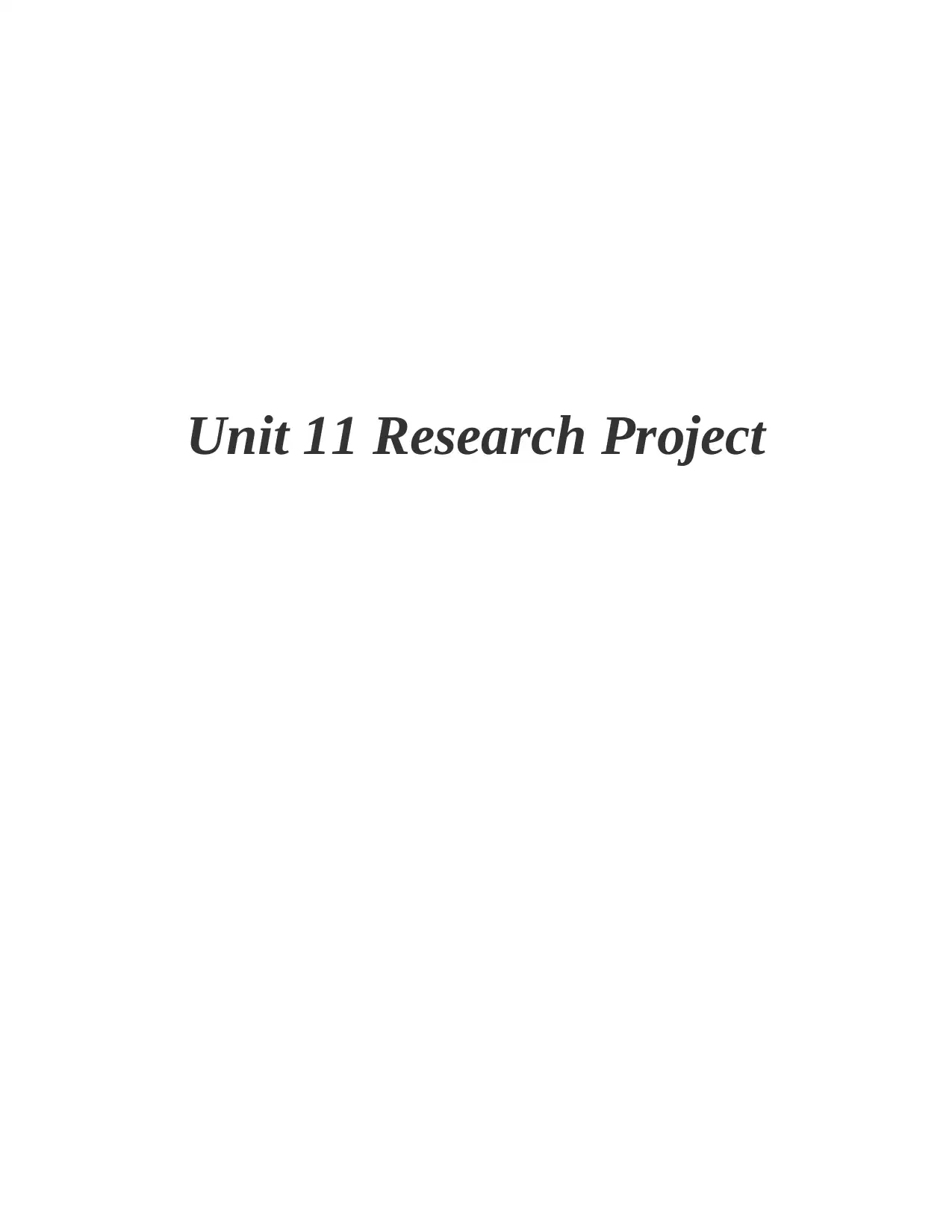
Unit 11 Research Project
Paraphrase This Document
Need a fresh take? Get an instant paraphrase of this document with our AI Paraphraser
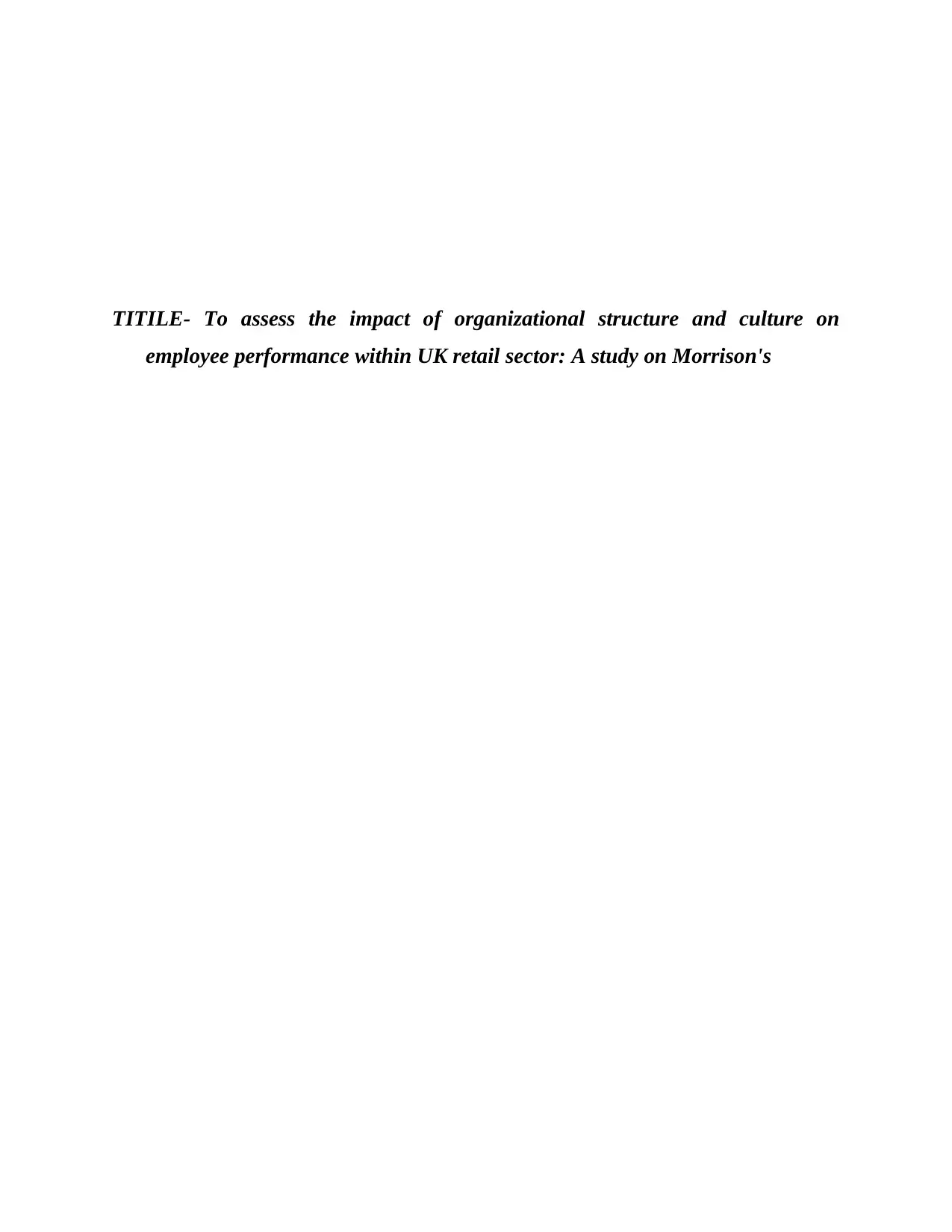
TITILE- To assess the impact of organizational structure and culture on
employee performance within UK retail sector: A study on Morrison's
employee performance within UK retail sector: A study on Morrison's
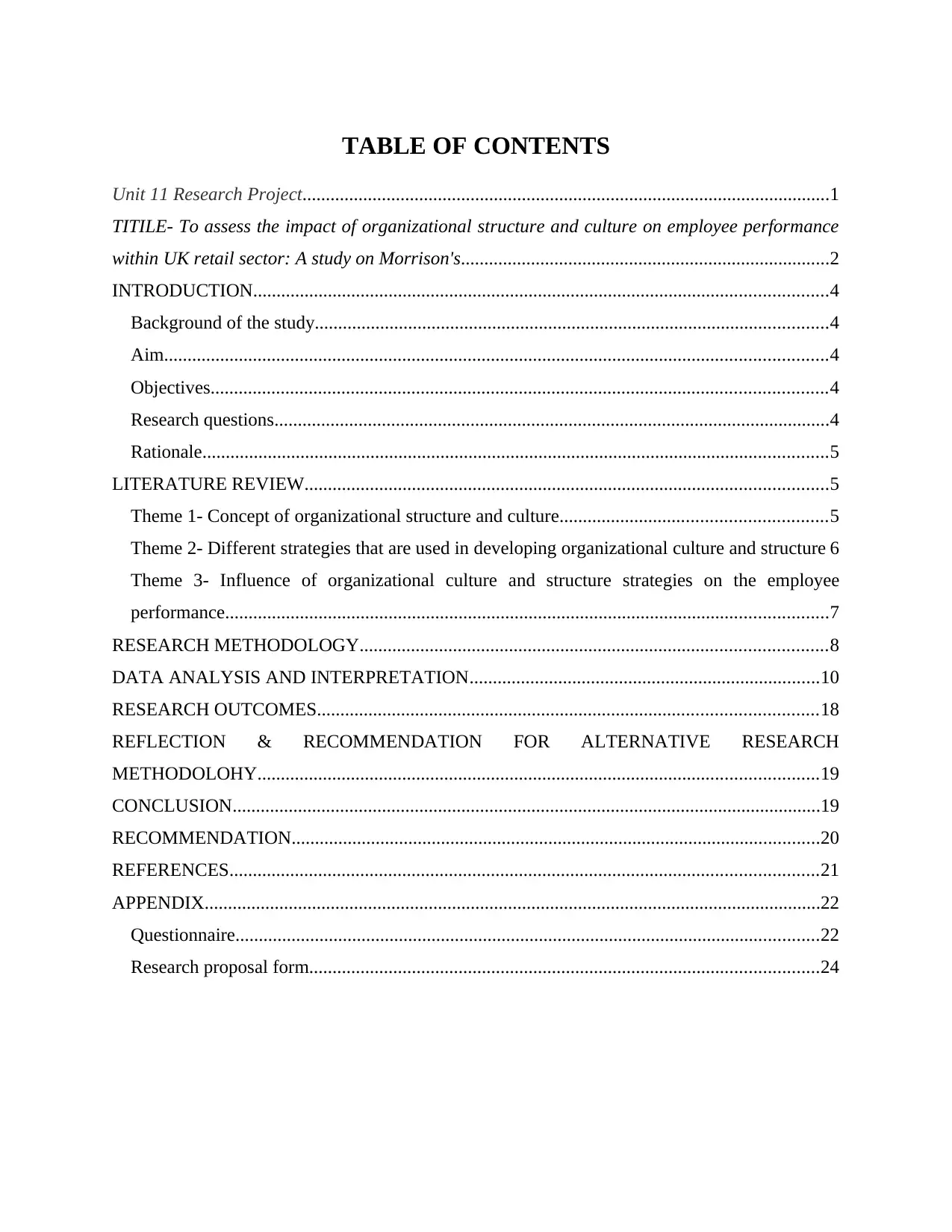
TABLE OF CONTENTS
Unit 11 Research Project.................................................................................................................1
TITILE- To assess the impact of organizational structure and culture on employee performance
within UK retail sector: A study on Morrison's...............................................................................2
INTRODUCTION...........................................................................................................................4
Background of the study..............................................................................................................4
Aim..............................................................................................................................................4
Objectives....................................................................................................................................4
Research questions.......................................................................................................................4
Rationale......................................................................................................................................5
LITERATURE REVIEW................................................................................................................5
Theme 1- Concept of organizational structure and culture.........................................................5
Theme 2- Different strategies that are used in developing organizational culture and structure 6
Theme 3- Influence of organizational culture and structure strategies on the employee
performance.................................................................................................................................7
RESEARCH METHODOLOGY....................................................................................................8
DATA ANALYSIS AND INTERPRETATION...........................................................................10
RESEARCH OUTCOMES...........................................................................................................18
REFLECTION & RECOMMENDATION FOR ALTERNATIVE RESEARCH
METHODOLOHY........................................................................................................................19
CONCLUSION..............................................................................................................................19
RECOMMENDATION.................................................................................................................20
REFERENCES..............................................................................................................................21
APPENDIX....................................................................................................................................22
Questionnaire.............................................................................................................................22
Research proposal form.............................................................................................................24
Unit 11 Research Project.................................................................................................................1
TITILE- To assess the impact of organizational structure and culture on employee performance
within UK retail sector: A study on Morrison's...............................................................................2
INTRODUCTION...........................................................................................................................4
Background of the study..............................................................................................................4
Aim..............................................................................................................................................4
Objectives....................................................................................................................................4
Research questions.......................................................................................................................4
Rationale......................................................................................................................................5
LITERATURE REVIEW................................................................................................................5
Theme 1- Concept of organizational structure and culture.........................................................5
Theme 2- Different strategies that are used in developing organizational culture and structure 6
Theme 3- Influence of organizational culture and structure strategies on the employee
performance.................................................................................................................................7
RESEARCH METHODOLOGY....................................................................................................8
DATA ANALYSIS AND INTERPRETATION...........................................................................10
RESEARCH OUTCOMES...........................................................................................................18
REFLECTION & RECOMMENDATION FOR ALTERNATIVE RESEARCH
METHODOLOHY........................................................................................................................19
CONCLUSION..............................................................................................................................19
RECOMMENDATION.................................................................................................................20
REFERENCES..............................................................................................................................21
APPENDIX....................................................................................................................................22
Questionnaire.............................................................................................................................22
Research proposal form.............................................................................................................24
⊘ This is a preview!⊘
Do you want full access?
Subscribe today to unlock all pages.

Trusted by 1+ million students worldwide
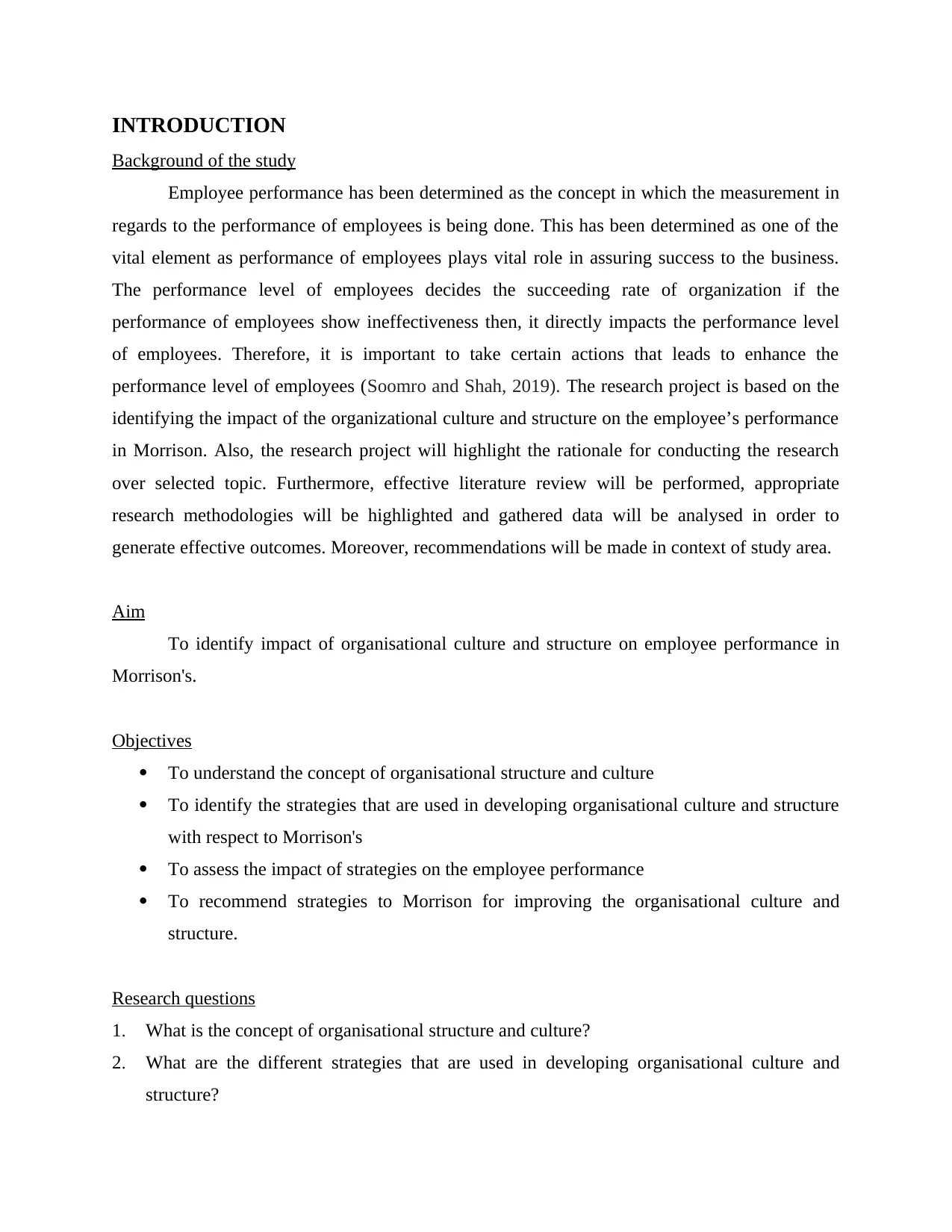
INTRODUCTION
Background of the study
Employee performance has been determined as the concept in which the measurement in
regards to the performance of employees is being done. This has been determined as one of the
vital element as performance of employees plays vital role in assuring success to the business.
The performance level of employees decides the succeeding rate of organization if the
performance of employees show ineffectiveness then, it directly impacts the performance level
of employees. Therefore, it is important to take certain actions that leads to enhance the
performance level of employees (Soomro and Shah, 2019). The research project is based on the
identifying the impact of the organizational culture and structure on the employee’s performance
in Morrison. Also, the research project will highlight the rationale for conducting the research
over selected topic. Furthermore, effective literature review will be performed, appropriate
research methodologies will be highlighted and gathered data will be analysed in order to
generate effective outcomes. Moreover, recommendations will be made in context of study area.
Aim
To identify impact of organisational culture and structure on employee performance in
Morrison's.
Objectives
To understand the concept of organisational structure and culture
To identify the strategies that are used in developing organisational culture and structure
with respect to Morrison's
To assess the impact of strategies on the employee performance
To recommend strategies to Morrison for improving the organisational culture and
structure.
Research questions
1. What is the concept of organisational structure and culture?
2. What are the different strategies that are used in developing organisational culture and
structure?
Background of the study
Employee performance has been determined as the concept in which the measurement in
regards to the performance of employees is being done. This has been determined as one of the
vital element as performance of employees plays vital role in assuring success to the business.
The performance level of employees decides the succeeding rate of organization if the
performance of employees show ineffectiveness then, it directly impacts the performance level
of employees. Therefore, it is important to take certain actions that leads to enhance the
performance level of employees (Soomro and Shah, 2019). The research project is based on the
identifying the impact of the organizational culture and structure on the employee’s performance
in Morrison. Also, the research project will highlight the rationale for conducting the research
over selected topic. Furthermore, effective literature review will be performed, appropriate
research methodologies will be highlighted and gathered data will be analysed in order to
generate effective outcomes. Moreover, recommendations will be made in context of study area.
Aim
To identify impact of organisational culture and structure on employee performance in
Morrison's.
Objectives
To understand the concept of organisational structure and culture
To identify the strategies that are used in developing organisational culture and structure
with respect to Morrison's
To assess the impact of strategies on the employee performance
To recommend strategies to Morrison for improving the organisational culture and
structure.
Research questions
1. What is the concept of organisational structure and culture?
2. What are the different strategies that are used in developing organisational culture and
structure?
Paraphrase This Document
Need a fresh take? Get an instant paraphrase of this document with our AI Paraphraser
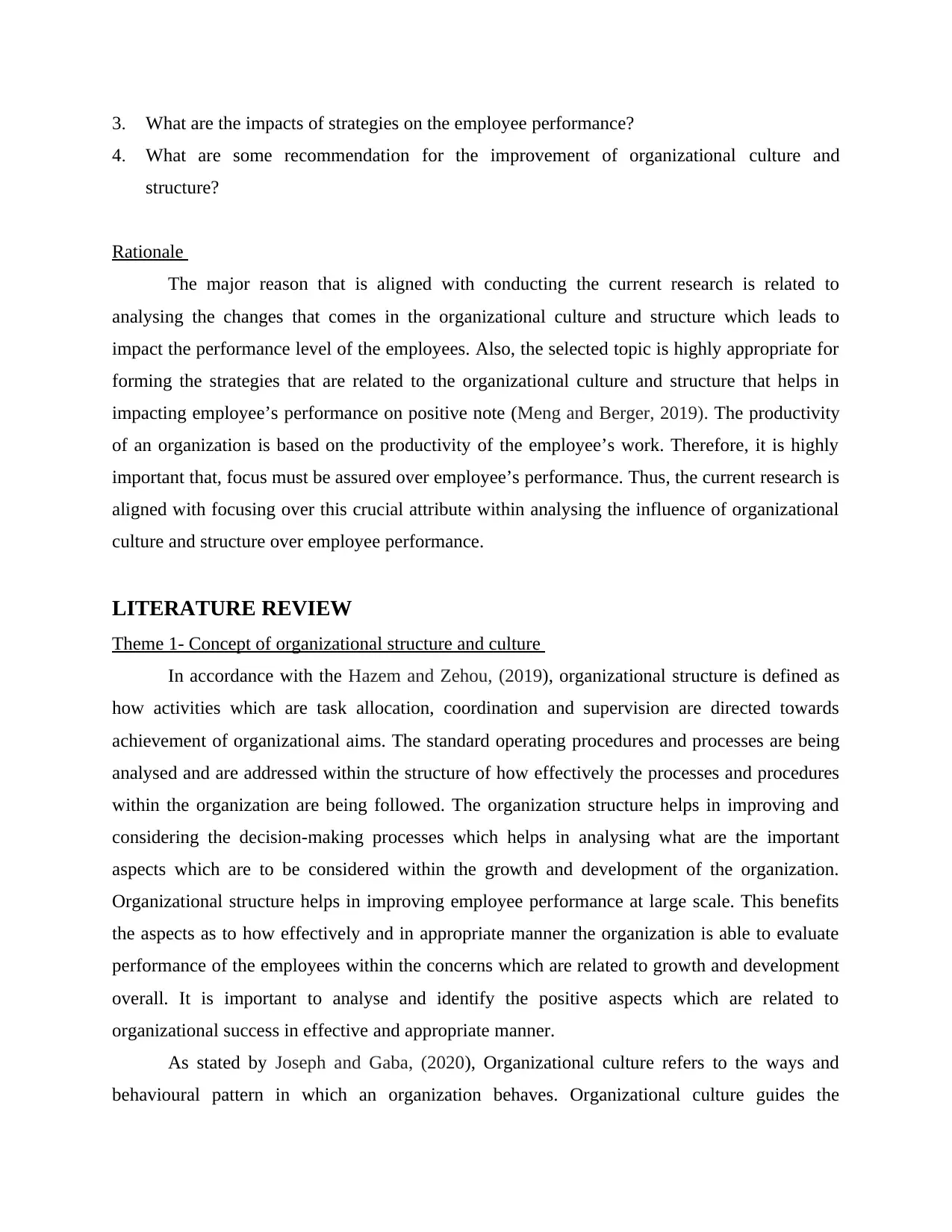
3. What are the impacts of strategies on the employee performance?
4. What are some recommendation for the improvement of organizational culture and
structure?
Rationale
The major reason that is aligned with conducting the current research is related to
analysing the changes that comes in the organizational culture and structure which leads to
impact the performance level of the employees. Also, the selected topic is highly appropriate for
forming the strategies that are related to the organizational culture and structure that helps in
impacting employee’s performance on positive note (Meng and Berger, 2019). The productivity
of an organization is based on the productivity of the employee’s work. Therefore, it is highly
important that, focus must be assured over employee’s performance. Thus, the current research is
aligned with focusing over this crucial attribute within analysing the influence of organizational
culture and structure over employee performance.
LITERATURE REVIEW
Theme 1- Concept of organizational structure and culture
In accordance with the Hazem and Zehou, (2019), organizational structure is defined as
how activities which are task allocation, coordination and supervision are directed towards
achievement of organizational aims. The standard operating procedures and processes are being
analysed and are addressed within the structure of how effectively the processes and procedures
within the organization are being followed. The organization structure helps in improving and
considering the decision-making processes which helps in analysing what are the important
aspects which are to be considered within the growth and development of the organization.
Organizational structure helps in improving employee performance at large scale. This benefits
the aspects as to how effectively and in appropriate manner the organization is able to evaluate
performance of the employees within the concerns which are related to growth and development
overall. It is important to analyse and identify the positive aspects which are related to
organizational success in effective and appropriate manner.
As stated by Joseph and Gaba, (2020), Organizational culture refers to the ways and
behavioural pattern in which an organization behaves. Organizational culture guides the
4. What are some recommendation for the improvement of organizational culture and
structure?
Rationale
The major reason that is aligned with conducting the current research is related to
analysing the changes that comes in the organizational culture and structure which leads to
impact the performance level of the employees. Also, the selected topic is highly appropriate for
forming the strategies that are related to the organizational culture and structure that helps in
impacting employee’s performance on positive note (Meng and Berger, 2019). The productivity
of an organization is based on the productivity of the employee’s work. Therefore, it is highly
important that, focus must be assured over employee’s performance. Thus, the current research is
aligned with focusing over this crucial attribute within analysing the influence of organizational
culture and structure over employee performance.
LITERATURE REVIEW
Theme 1- Concept of organizational structure and culture
In accordance with the Hazem and Zehou, (2019), organizational structure is defined as
how activities which are task allocation, coordination and supervision are directed towards
achievement of organizational aims. The standard operating procedures and processes are being
analysed and are addressed within the structure of how effectively the processes and procedures
within the organization are being followed. The organization structure helps in improving and
considering the decision-making processes which helps in analysing what are the important
aspects which are to be considered within the growth and development of the organization.
Organizational structure helps in improving employee performance at large scale. This benefits
the aspects as to how effectively and in appropriate manner the organization is able to evaluate
performance of the employees within the concerns which are related to growth and development
overall. It is important to analyse and identify the positive aspects which are related to
organizational success in effective and appropriate manner.
As stated by Joseph and Gaba, (2020), Organizational culture refers to the ways and
behavioural pattern in which an organization behaves. Organizational culture guides the
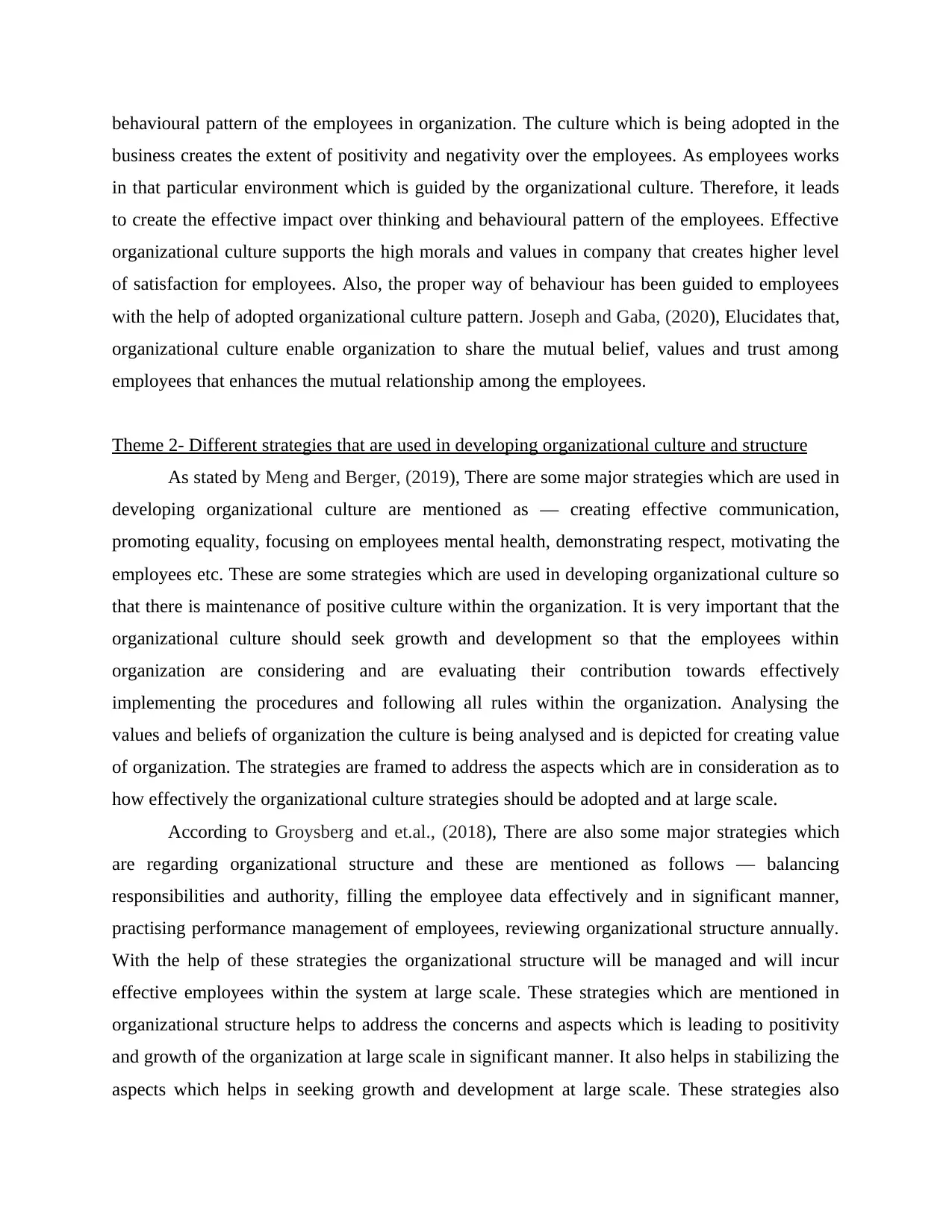
behavioural pattern of the employees in organization. The culture which is being adopted in the
business creates the extent of positivity and negativity over the employees. As employees works
in that particular environment which is guided by the organizational culture. Therefore, it leads
to create the effective impact over thinking and behavioural pattern of the employees. Effective
organizational culture supports the high morals and values in company that creates higher level
of satisfaction for employees. Also, the proper way of behaviour has been guided to employees
with the help of adopted organizational culture pattern. Joseph and Gaba, (2020), Elucidates that,
organizational culture enable organization to share the mutual belief, values and trust among
employees that enhances the mutual relationship among the employees.
Theme 2- Different strategies that are used in developing organizational culture and structure
As stated by Meng and Berger, (2019), There are some major strategies which are used in
developing organizational culture are mentioned as — creating effective communication,
promoting equality, focusing on employees mental health, demonstrating respect, motivating the
employees etc. These are some strategies which are used in developing organizational culture so
that there is maintenance of positive culture within the organization. It is very important that the
organizational culture should seek growth and development so that the employees within
organization are considering and are evaluating their contribution towards effectively
implementing the procedures and following all rules within the organization. Analysing the
values and beliefs of organization the culture is being analysed and is depicted for creating value
of organization. The strategies are framed to address the aspects which are in consideration as to
how effectively the organizational culture strategies should be adopted and at large scale.
According to Groysberg and et.al., (2018), There are also some major strategies which
are regarding organizational structure and these are mentioned as follows — balancing
responsibilities and authority, filling the employee data effectively and in significant manner,
practising performance management of employees, reviewing organizational structure annually.
With the help of these strategies the organizational structure will be managed and will incur
effective employees within the system at large scale. These strategies which are mentioned in
organizational structure helps to address the concerns and aspects which is leading to positivity
and growth of the organization at large scale in significant manner. It also helps in stabilizing the
aspects which helps in seeking growth and development at large scale. These strategies also
business creates the extent of positivity and negativity over the employees. As employees works
in that particular environment which is guided by the organizational culture. Therefore, it leads
to create the effective impact over thinking and behavioural pattern of the employees. Effective
organizational culture supports the high morals and values in company that creates higher level
of satisfaction for employees. Also, the proper way of behaviour has been guided to employees
with the help of adopted organizational culture pattern. Joseph and Gaba, (2020), Elucidates that,
organizational culture enable organization to share the mutual belief, values and trust among
employees that enhances the mutual relationship among the employees.
Theme 2- Different strategies that are used in developing organizational culture and structure
As stated by Meng and Berger, (2019), There are some major strategies which are used in
developing organizational culture are mentioned as — creating effective communication,
promoting equality, focusing on employees mental health, demonstrating respect, motivating the
employees etc. These are some strategies which are used in developing organizational culture so
that there is maintenance of positive culture within the organization. It is very important that the
organizational culture should seek growth and development so that the employees within
organization are considering and are evaluating their contribution towards effectively
implementing the procedures and following all rules within the organization. Analysing the
values and beliefs of organization the culture is being analysed and is depicted for creating value
of organization. The strategies are framed to address the aspects which are in consideration as to
how effectively the organizational culture strategies should be adopted and at large scale.
According to Groysberg and et.al., (2018), There are also some major strategies which
are regarding organizational structure and these are mentioned as follows — balancing
responsibilities and authority, filling the employee data effectively and in significant manner,
practising performance management of employees, reviewing organizational structure annually.
With the help of these strategies the organizational structure will be managed and will incur
effective employees within the system at large scale. These strategies which are mentioned in
organizational structure helps to address the concerns and aspects which is leading to positivity
and growth of the organization at large scale in significant manner. It also helps in stabilizing the
aspects which helps in seeking growth and development at large scale. These strategies also
⊘ This is a preview!⊘
Do you want full access?
Subscribe today to unlock all pages.

Trusted by 1+ million students worldwide
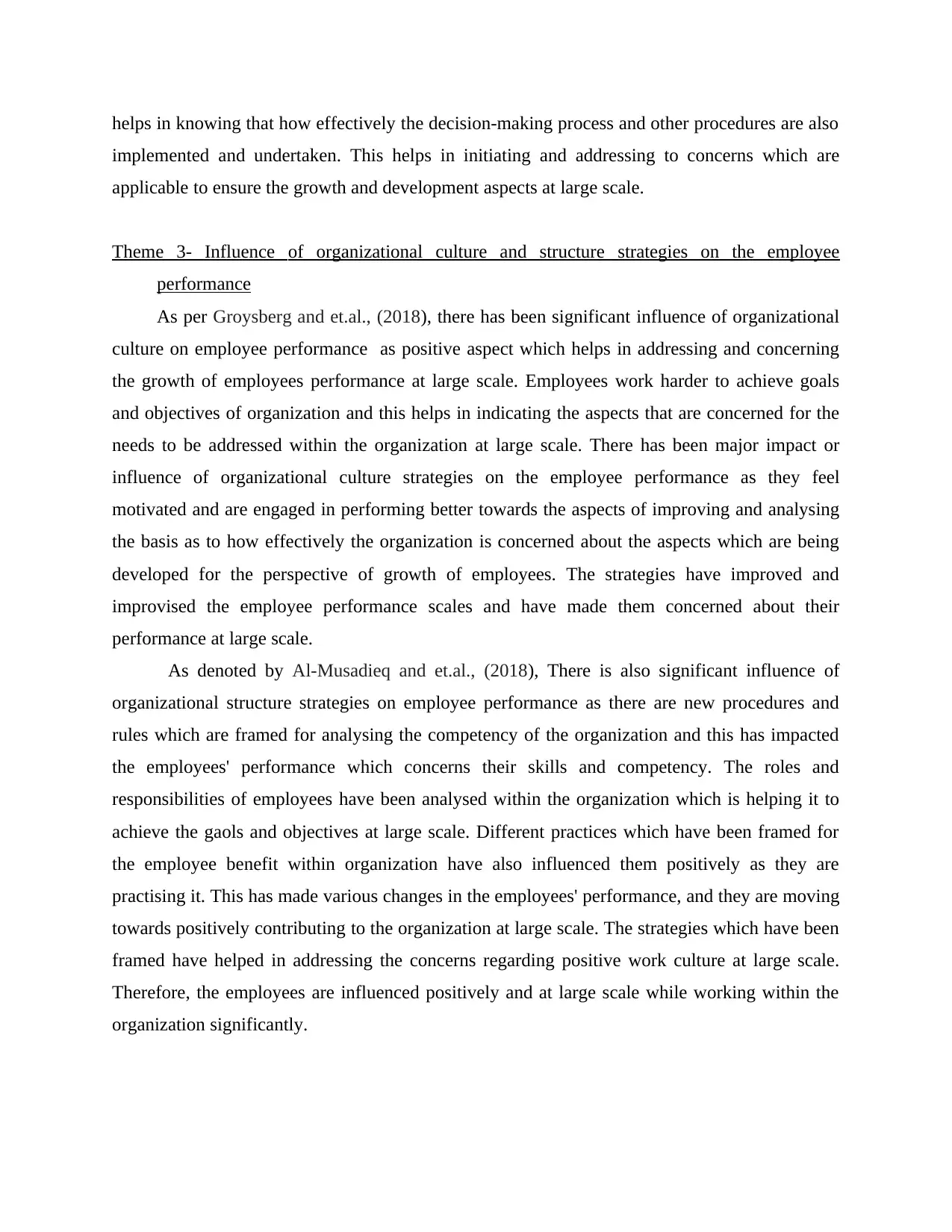
helps in knowing that how effectively the decision-making process and other procedures are also
implemented and undertaken. This helps in initiating and addressing to concerns which are
applicable to ensure the growth and development aspects at large scale.
Theme 3- Influence of organizational culture and structure strategies on the employee
performance
As per Groysberg and et.al., (2018), there has been significant influence of organizational
culture on employee performance as positive aspect which helps in addressing and concerning
the growth of employees performance at large scale. Employees work harder to achieve goals
and objectives of organization and this helps in indicating the aspects that are concerned for the
needs to be addressed within the organization at large scale. There has been major impact or
influence of organizational culture strategies on the employee performance as they feel
motivated and are engaged in performing better towards the aspects of improving and analysing
the basis as to how effectively the organization is concerned about the aspects which are being
developed for the perspective of growth of employees. The strategies have improved and
improvised the employee performance scales and have made them concerned about their
performance at large scale.
As denoted by Al-Musadieq and et.al., (2018), There is also significant influence of
organizational structure strategies on employee performance as there are new procedures and
rules which are framed for analysing the competency of the organization and this has impacted
the employees' performance which concerns their skills and competency. The roles and
responsibilities of employees have been analysed within the organization which is helping it to
achieve the gaols and objectives at large scale. Different practices which have been framed for
the employee benefit within organization have also influenced them positively as they are
practising it. This has made various changes in the employees' performance, and they are moving
towards positively contributing to the organization at large scale. The strategies which have been
framed have helped in addressing the concerns regarding positive work culture at large scale.
Therefore, the employees are influenced positively and at large scale while working within the
organization significantly.
implemented and undertaken. This helps in initiating and addressing to concerns which are
applicable to ensure the growth and development aspects at large scale.
Theme 3- Influence of organizational culture and structure strategies on the employee
performance
As per Groysberg and et.al., (2018), there has been significant influence of organizational
culture on employee performance as positive aspect which helps in addressing and concerning
the growth of employees performance at large scale. Employees work harder to achieve goals
and objectives of organization and this helps in indicating the aspects that are concerned for the
needs to be addressed within the organization at large scale. There has been major impact or
influence of organizational culture strategies on the employee performance as they feel
motivated and are engaged in performing better towards the aspects of improving and analysing
the basis as to how effectively the organization is concerned about the aspects which are being
developed for the perspective of growth of employees. The strategies have improved and
improvised the employee performance scales and have made them concerned about their
performance at large scale.
As denoted by Al-Musadieq and et.al., (2018), There is also significant influence of
organizational structure strategies on employee performance as there are new procedures and
rules which are framed for analysing the competency of the organization and this has impacted
the employees' performance which concerns their skills and competency. The roles and
responsibilities of employees have been analysed within the organization which is helping it to
achieve the gaols and objectives at large scale. Different practices which have been framed for
the employee benefit within organization have also influenced them positively as they are
practising it. This has made various changes in the employees' performance, and they are moving
towards positively contributing to the organization at large scale. The strategies which have been
framed have helped in addressing the concerns regarding positive work culture at large scale.
Therefore, the employees are influenced positively and at large scale while working within the
organization significantly.
Paraphrase This Document
Need a fresh take? Get an instant paraphrase of this document with our AI Paraphraser
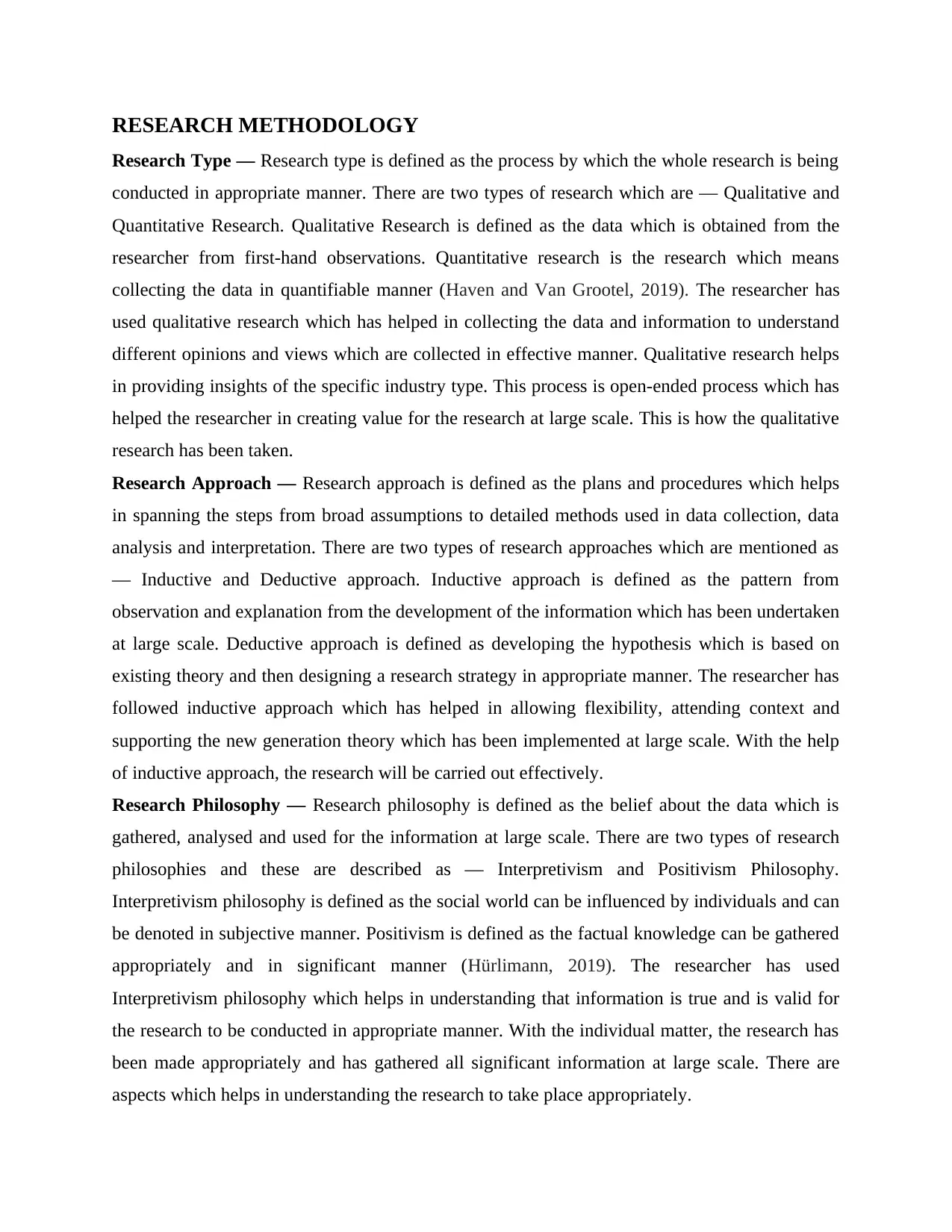
RESEARCH METHODOLOGY
Research Type — Research type is defined as the process by which the whole research is being
conducted in appropriate manner. There are two types of research which are — Qualitative and
Quantitative Research. Qualitative Research is defined as the data which is obtained from the
researcher from first-hand observations. Quantitative research is the research which means
collecting the data in quantifiable manner (Haven and Van Grootel, 2019). The researcher has
used qualitative research which has helped in collecting the data and information to understand
different opinions and views which are collected in effective manner. Qualitative research helps
in providing insights of the specific industry type. This process is open-ended process which has
helped the researcher in creating value for the research at large scale. This is how the qualitative
research has been taken.
Research Approach — Research approach is defined as the plans and procedures which helps
in spanning the steps from broad assumptions to detailed methods used in data collection, data
analysis and interpretation. There are two types of research approaches which are mentioned as
— Inductive and Deductive approach. Inductive approach is defined as the pattern from
observation and explanation from the development of the information which has been undertaken
at large scale. Deductive approach is defined as developing the hypothesis which is based on
existing theory and then designing a research strategy in appropriate manner. The researcher has
followed inductive approach which has helped in allowing flexibility, attending context and
supporting the new generation theory which has been implemented at large scale. With the help
of inductive approach, the research will be carried out effectively.
Research Philosophy — Research philosophy is defined as the belief about the data which is
gathered, analysed and used for the information at large scale. There are two types of research
philosophies and these are described as — Interpretivism and Positivism Philosophy.
Interpretivism philosophy is defined as the social world can be influenced by individuals and can
be denoted in subjective manner. Positivism is defined as the factual knowledge can be gathered
appropriately and in significant manner (Hürlimann, 2019). The researcher has used
Interpretivism philosophy which helps in understanding that information is true and is valid for
the research to be conducted in appropriate manner. With the individual matter, the research has
been made appropriately and has gathered all significant information at large scale. There are
aspects which helps in understanding the research to take place appropriately.
Research Type — Research type is defined as the process by which the whole research is being
conducted in appropriate manner. There are two types of research which are — Qualitative and
Quantitative Research. Qualitative Research is defined as the data which is obtained from the
researcher from first-hand observations. Quantitative research is the research which means
collecting the data in quantifiable manner (Haven and Van Grootel, 2019). The researcher has
used qualitative research which has helped in collecting the data and information to understand
different opinions and views which are collected in effective manner. Qualitative research helps
in providing insights of the specific industry type. This process is open-ended process which has
helped the researcher in creating value for the research at large scale. This is how the qualitative
research has been taken.
Research Approach — Research approach is defined as the plans and procedures which helps
in spanning the steps from broad assumptions to detailed methods used in data collection, data
analysis and interpretation. There are two types of research approaches which are mentioned as
— Inductive and Deductive approach. Inductive approach is defined as the pattern from
observation and explanation from the development of the information which has been undertaken
at large scale. Deductive approach is defined as developing the hypothesis which is based on
existing theory and then designing a research strategy in appropriate manner. The researcher has
followed inductive approach which has helped in allowing flexibility, attending context and
supporting the new generation theory which has been implemented at large scale. With the help
of inductive approach, the research will be carried out effectively.
Research Philosophy — Research philosophy is defined as the belief about the data which is
gathered, analysed and used for the information at large scale. There are two types of research
philosophies and these are described as — Interpretivism and Positivism Philosophy.
Interpretivism philosophy is defined as the social world can be influenced by individuals and can
be denoted in subjective manner. Positivism is defined as the factual knowledge can be gathered
appropriately and in significant manner (Hürlimann, 2019). The researcher has used
Interpretivism philosophy which helps in understanding that information is true and is valid for
the research to be conducted in appropriate manner. With the individual matter, the research has
been made appropriately and has gathered all significant information at large scale. There are
aspects which helps in understanding the research to take place appropriately.
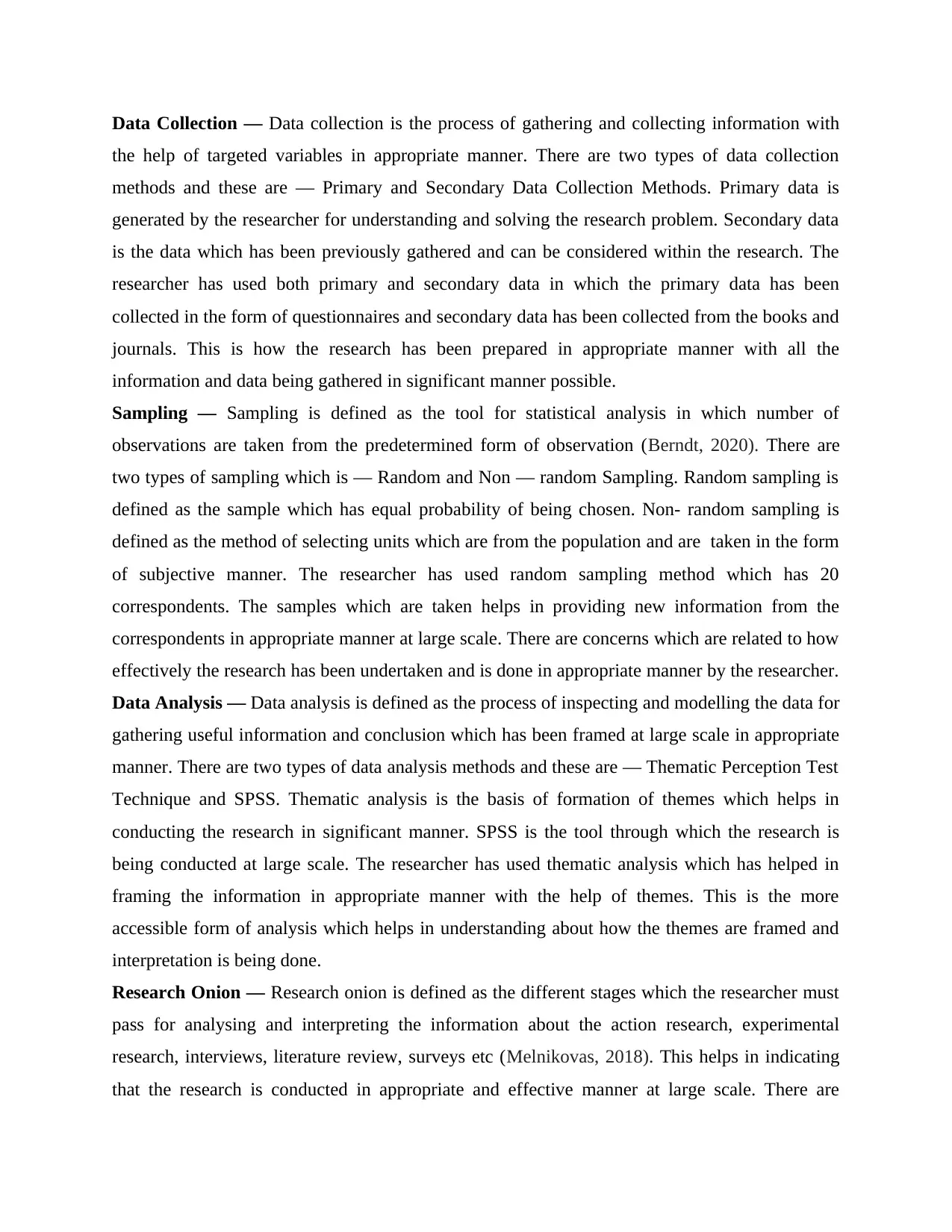
Data Collection — Data collection is the process of gathering and collecting information with
the help of targeted variables in appropriate manner. There are two types of data collection
methods and these are — Primary and Secondary Data Collection Methods. Primary data is
generated by the researcher for understanding and solving the research problem. Secondary data
is the data which has been previously gathered and can be considered within the research. The
researcher has used both primary and secondary data in which the primary data has been
collected in the form of questionnaires and secondary data has been collected from the books and
journals. This is how the research has been prepared in appropriate manner with all the
information and data being gathered in significant manner possible.
Sampling — Sampling is defined as the tool for statistical analysis in which number of
observations are taken from the predetermined form of observation (Berndt, 2020). There are
two types of sampling which is — Random and Non — random Sampling. Random sampling is
defined as the sample which has equal probability of being chosen. Non- random sampling is
defined as the method of selecting units which are from the population and are taken in the form
of subjective manner. The researcher has used random sampling method which has 20
correspondents. The samples which are taken helps in providing new information from the
correspondents in appropriate manner at large scale. There are concerns which are related to how
effectively the research has been undertaken and is done in appropriate manner by the researcher.
Data Analysis — Data analysis is defined as the process of inspecting and modelling the data for
gathering useful information and conclusion which has been framed at large scale in appropriate
manner. There are two types of data analysis methods and these are — Thematic Perception Test
Technique and SPSS. Thematic analysis is the basis of formation of themes which helps in
conducting the research in significant manner. SPSS is the tool through which the research is
being conducted at large scale. The researcher has used thematic analysis which has helped in
framing the information in appropriate manner with the help of themes. This is the more
accessible form of analysis which helps in understanding about how the themes are framed and
interpretation is being done.
Research Onion — Research onion is defined as the different stages which the researcher must
pass for analysing and interpreting the information about the action research, experimental
research, interviews, literature review, surveys etc (Melnikovas, 2018). This helps in indicating
that the research is conducted in appropriate and effective manner at large scale. There are
the help of targeted variables in appropriate manner. There are two types of data collection
methods and these are — Primary and Secondary Data Collection Methods. Primary data is
generated by the researcher for understanding and solving the research problem. Secondary data
is the data which has been previously gathered and can be considered within the research. The
researcher has used both primary and secondary data in which the primary data has been
collected in the form of questionnaires and secondary data has been collected from the books and
journals. This is how the research has been prepared in appropriate manner with all the
information and data being gathered in significant manner possible.
Sampling — Sampling is defined as the tool for statistical analysis in which number of
observations are taken from the predetermined form of observation (Berndt, 2020). There are
two types of sampling which is — Random and Non — random Sampling. Random sampling is
defined as the sample which has equal probability of being chosen. Non- random sampling is
defined as the method of selecting units which are from the population and are taken in the form
of subjective manner. The researcher has used random sampling method which has 20
correspondents. The samples which are taken helps in providing new information from the
correspondents in appropriate manner at large scale. There are concerns which are related to how
effectively the research has been undertaken and is done in appropriate manner by the researcher.
Data Analysis — Data analysis is defined as the process of inspecting and modelling the data for
gathering useful information and conclusion which has been framed at large scale in appropriate
manner. There are two types of data analysis methods and these are — Thematic Perception Test
Technique and SPSS. Thematic analysis is the basis of formation of themes which helps in
conducting the research in significant manner. SPSS is the tool through which the research is
being conducted at large scale. The researcher has used thematic analysis which has helped in
framing the information in appropriate manner with the help of themes. This is the more
accessible form of analysis which helps in understanding about how the themes are framed and
interpretation is being done.
Research Onion — Research onion is defined as the different stages which the researcher must
pass for analysing and interpreting the information about the action research, experimental
research, interviews, literature review, surveys etc (Melnikovas, 2018). This helps in indicating
that the research is conducted in appropriate and effective manner at large scale. There are
⊘ This is a preview!⊘
Do you want full access?
Subscribe today to unlock all pages.

Trusted by 1+ million students worldwide
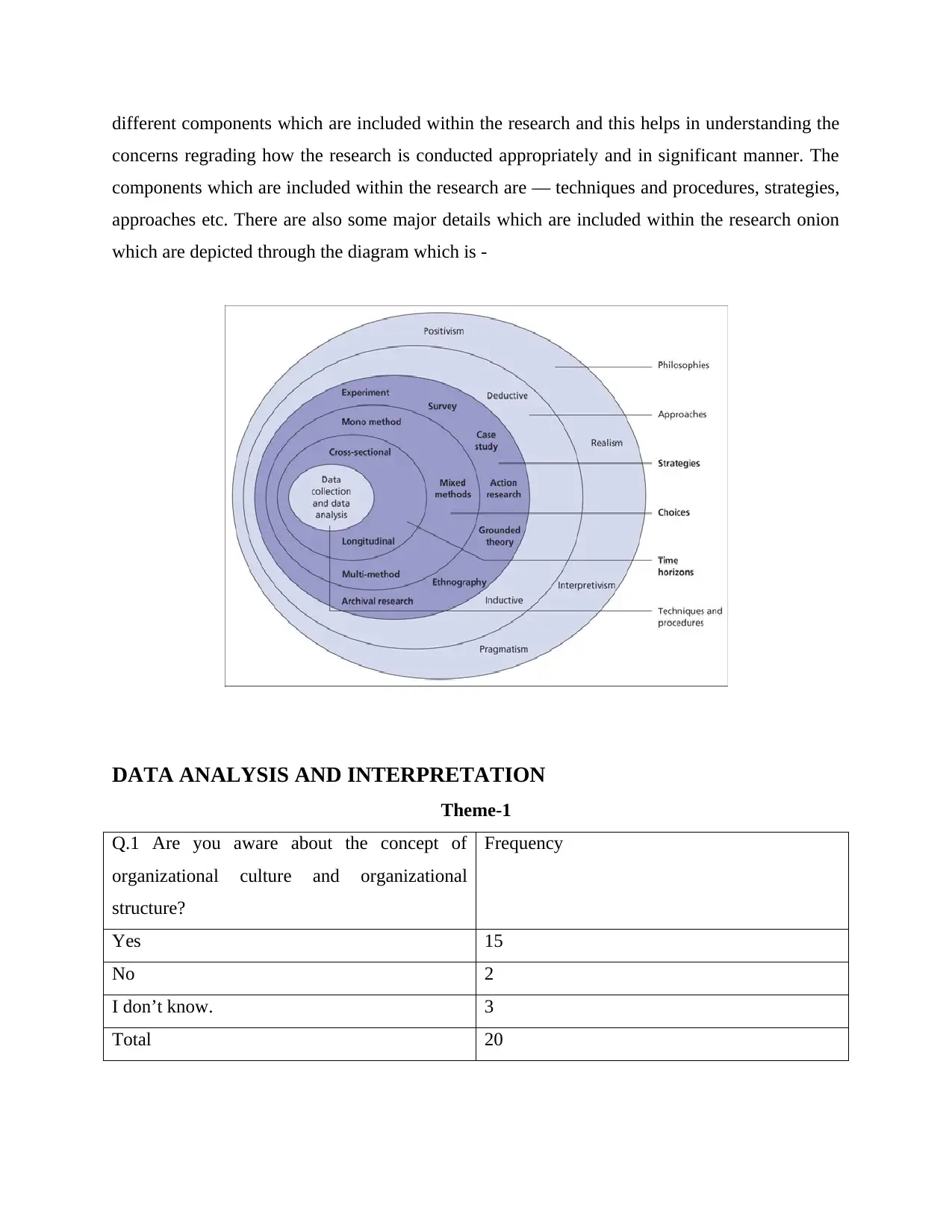
different components which are included within the research and this helps in understanding the
concerns regrading how the research is conducted appropriately and in significant manner. The
components which are included within the research are — techniques and procedures, strategies,
approaches etc. There are also some major details which are included within the research onion
which are depicted through the diagram which is -
DATA ANALYSIS AND INTERPRETATION
Theme-1
Q.1 Are you aware about the concept of
organizational culture and organizational
structure?
Frequency
Yes 15
No 2
I don’t know. 3
Total 20
concerns regrading how the research is conducted appropriately and in significant manner. The
components which are included within the research are — techniques and procedures, strategies,
approaches etc. There are also some major details which are included within the research onion
which are depicted through the diagram which is -
DATA ANALYSIS AND INTERPRETATION
Theme-1
Q.1 Are you aware about the concept of
organizational culture and organizational
structure?
Frequency
Yes 15
No 2
I don’t know. 3
Total 20
Paraphrase This Document
Need a fresh take? Get an instant paraphrase of this document with our AI Paraphraser
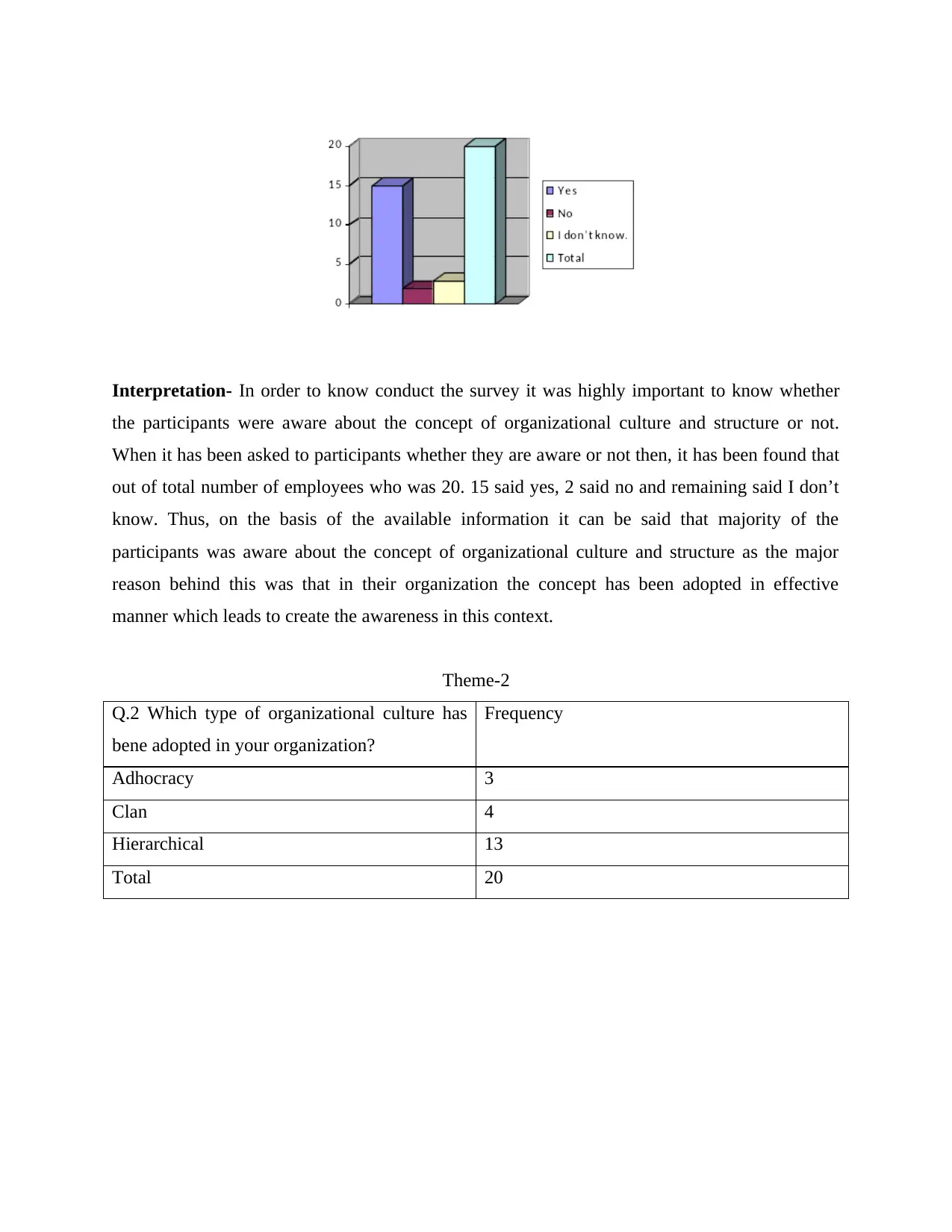
Interpretation- In order to know conduct the survey it was highly important to know whether
the participants were aware about the concept of organizational culture and structure or not.
When it has been asked to participants whether they are aware or not then, it has been found that
out of total number of employees who was 20. 15 said yes, 2 said no and remaining said I don’t
know. Thus, on the basis of the available information it can be said that majority of the
participants was aware about the concept of organizational culture and structure as the major
reason behind this was that in their organization the concept has been adopted in effective
manner which leads to create the awareness in this context.
Theme-2
Q.2 Which type of organizational culture has
bene adopted in your organization?
Frequency
Adhocracy 3
Clan 4
Hierarchical 13
Total 20
the participants were aware about the concept of organizational culture and structure or not.
When it has been asked to participants whether they are aware or not then, it has been found that
out of total number of employees who was 20. 15 said yes, 2 said no and remaining said I don’t
know. Thus, on the basis of the available information it can be said that majority of the
participants was aware about the concept of organizational culture and structure as the major
reason behind this was that in their organization the concept has been adopted in effective
manner which leads to create the awareness in this context.
Theme-2
Q.2 Which type of organizational culture has
bene adopted in your organization?
Frequency
Adhocracy 3
Clan 4
Hierarchical 13
Total 20
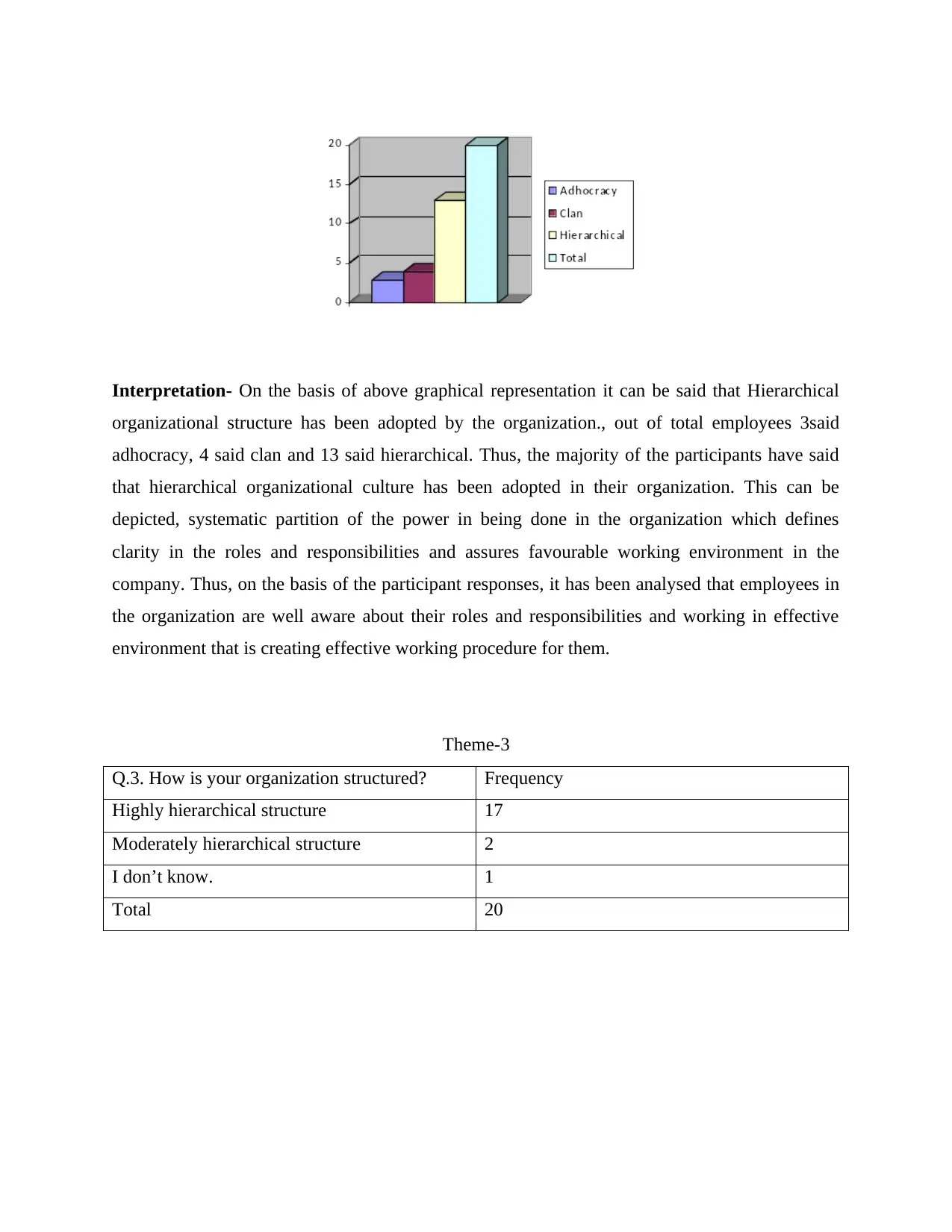
Interpretation- On the basis of above graphical representation it can be said that Hierarchical
organizational structure has been adopted by the organization., out of total employees 3said
adhocracy, 4 said clan and 13 said hierarchical. Thus, the majority of the participants have said
that hierarchical organizational culture has been adopted in their organization. This can be
depicted, systematic partition of the power in being done in the organization which defines
clarity in the roles and responsibilities and assures favourable working environment in the
company. Thus, on the basis of the participant responses, it has been analysed that employees in
the organization are well aware about their roles and responsibilities and working in effective
environment that is creating effective working procedure for them.
Theme-3
Q.3. How is your organization structured? Frequency
Highly hierarchical structure 17
Moderately hierarchical structure 2
I don’t know. 1
Total 20
organizational structure has been adopted by the organization., out of total employees 3said
adhocracy, 4 said clan and 13 said hierarchical. Thus, the majority of the participants have said
that hierarchical organizational culture has been adopted in their organization. This can be
depicted, systematic partition of the power in being done in the organization which defines
clarity in the roles and responsibilities and assures favourable working environment in the
company. Thus, on the basis of the participant responses, it has been analysed that employees in
the organization are well aware about their roles and responsibilities and working in effective
environment that is creating effective working procedure for them.
Theme-3
Q.3. How is your organization structured? Frequency
Highly hierarchical structure 17
Moderately hierarchical structure 2
I don’t know. 1
Total 20
⊘ This is a preview!⊘
Do you want full access?
Subscribe today to unlock all pages.

Trusted by 1+ million students worldwide
1 out of 38
Related Documents
Your All-in-One AI-Powered Toolkit for Academic Success.
+13062052269
info@desklib.com
Available 24*7 on WhatsApp / Email
![[object Object]](/_next/static/media/star-bottom.7253800d.svg)
Unlock your academic potential
Copyright © 2020–2025 A2Z Services. All Rights Reserved. Developed and managed by ZUCOL.





